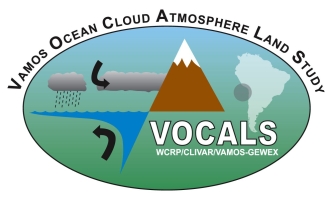PreVOCA: VOCALS Model Assessment March 2008 Funding for PreVOCA is provided by the National Science Foundation and the National Oceanographic and Atmospheric Administration, with additional contributions from various national and international research institutions. |
 |
VOCALS Homepage | VOCALS at the University of Washington | Rob Wood's homepage
News: October 10th 2007: |
GOAL: Critically assess the ability of global and regional atmospheric, oceanic, and chemical transport models to simulate and predict synoptically-varying clouds, meteorology, ocean circulation and aerosols in the southeast Pacific (SEP) subtropical stratocumulus regime for a month in the southern spring season. All participating models must be run in some form of weather forecast mode. WHY? VOCALS is predicated on the need to 1) reduce the systematic biases of atmosphereocean GCMs in the SEP, 2) improve understanding and simulation of aerosol-cloud-drizzle interactions in the marine PBL, and 3) improve understanding and simulation of ocean budgets of heat and salinity in the SEP. Therefore we need to assess the performance of model simulations of the atmosphere-ocean-aerosol in the region. In addition, the sampling strategy during the VOCALS Regional Experiment (REx) in October 2008 will critically depend on the weather conditions and hence on the regional forecasts for the region. Therefore we need to assess the models’ ability to predict typical patterns of synoptic scale variability over the region where VOCALS Rex will take place. SEP? The SEP contains the world’s most persistent subtropical stratocumulus region. The meteorology is simpler than the more-studied northeast Pacific due to the low latitudes and the flow channeling by the high Andes. There is a persistent aerosol contrast between the coasts of Northern Chile and Peru, polluted by sulfate from copper smelters and other industrial activity, and the pristine flow offshore where biogenic and salt aerosol may dominate. In the clean offshore air large POCS (patches of open cells) regularly form within the solid stratocumulus sheet and last for days, possibly maintained by feedbacks between drizzle and aerosol scavenging. New satellite instruments and algorithms are giving a much more integrated view of oceanic clouds that we have had before, turning the SEP from a data void into a feast of new observations. These are supplemented in the SEP by research-grade buoy measurements and limited research cruise data. Lastly, the VOCALS-REx field experiment in Oct.-Nov. 2008 will take many detailed in-situ measurements in the SEP. SIMULATED PERIOD: Oct. 2006. This is the SEP stratocumulus maximum, has POCs, includes a week of in-situ data (soundings, ship remote sensing, and aerosols) from a buoy maintenance cruise. 4xdaily outputs (see below) WHEN? Submissions to Rob Wood (robwood@atmos.washington.edu) by Jan. 31, 2007 WHO? Model outputs will be archived at the University of Washington and will be analyzed by Wood, Bretherton and Mechoso. The UW and UCLA groups will each share the procurement and assembly of the various satellite datasets. |